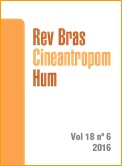Aerobic fitness profile of youth soccer players: effects of chronological age and playing position
DOI:
https://doi.org/10.1590/1980-0037.2016v18n6p700Abstract
To establish a profile of the aerobic fitness in young soccer players, it is critical to consider different intervenient factors such as maturity status, chronological age and playing position. The aim of this study was to identify the biological maturation, chronological age, and playing position effects on physical and physiological characteristics of young soccer players. Two hundred and one soccer players of 11-19 years old were divided into groups relative to their maturity status, chronological age and playing position. A maximal exercise test was performed to determine peak oxygen uptake (VO2peak) and ventilatory thresholds (VT1 and VT2) parameters in a treadmill. Biological maturation showed no significant effect on relative values (mL.kg-1.min-1) of VO2peak, VT2 and VT1 (0.004 < h2 < 0.039), but showed large positive effect on maximal aerobic speed (MAS) and speed at VT2 (VT2speed). Chronological age showed a medium positive effect on relative values of VO2peak, VT2 and VT1 (0.095 < h2 < 0.137) and a large positive effect on MAS and VT2speed. Relative values of VO2peak and VT1 showed no significant differences among groups for playing position (P>0.05; 0.044 < h2 < 0.051). However, goalkeepers showed significant lower relative values for VT2 and VT2speed than other playing positions and a medium positive effect was observed (P<0.05; 0.077 < h2 < 0.119). Chronological age showed a medium to large positive effect on aerobic fitness parameters, while biological maturation showed a positive effect only on MAS and VT2speed. Playing position showed a medium positive effect on VT2 and VT2speed.



